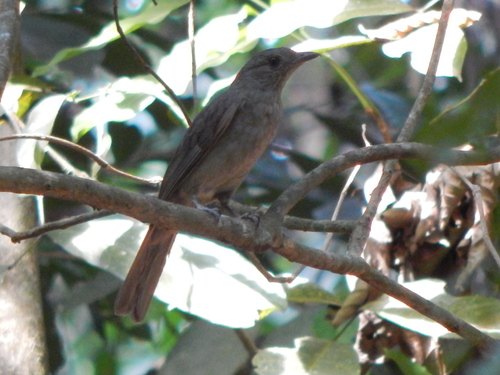
Screaming Piha
The Screaming Piha (*Lipaugus vociferans*) is a South American bird renowned for its extraordinarily loud and distinctive call, often described as one of the loudest bird vocalizations in the world. This iconic sound, a piercing "pi-ha" or a drawn-out whistle, dominates the soundscape of the Amazon rainforest. Ecologically, the Screaming Piha plays a role in seed dispersal as a frugivore. While not known for vibrant plumage, its vocal prowess has made it a subject of fascination for ornithologists and birdwatchers alike, and the sound will be known to anyone that has spent time in the forest, even if they have not seen the bird.
25-28 cm
Length
Unknown cm
Wingspan
Least Concern
Conservation Status
Distribution
The Screaming Piha is widely distributed across the Amazon Basin, including parts of Brazil, Colombia, Peru, Ecuador, Venezuela, Guyana, Suriname, and French Guiana. It is primarily found in lowland rainforests.
Lifespan
Unknown, but likely several years in the wild.
Screaming Piha's Habitat
Habitat Types
Humid lowland forests, Terra firme forests, Várzea (seasonally flooded) forests
Climate Zones
Tropical
Adaptations
The Screaming Piha's preference for dense rainforest provides cover from predators. Its relatively drab plumage offers camouflage within the forest canopy, where it often perches.
Variations
No well-defined subspecies are widely recognized, although some minor plumage variations may occur across its vast range.
Appearance
Breeding Plumage
No significant difference between breeding and non-breeding plumage.
Seasonal Feather Changes
No significant seasonal variations.
Sex Based Plumage Differences
Males and females have similar, predominantly grey plumage.
Notable Features
Unremarkable grey plumage, Slightly darker grey on the wings and tail, Robust build
Diet and Feeding
Primary Foods
Fruits, Insects
Foraging Behavior
Primarily frugivorous, consuming a wide variety of fruits from rainforest trees and shrubs. It also gleans insects from foliage and occasionally catches them in flight.
Specializations
No highly specialized feeding adaptations, but its strong beak allows it to handle a variety of fruit sizes.
Seasonal Diet Variations
Diet may shift slightly depending on fruit availability throughout the year, with increased insect consumption during periods of fruit scarcity.
Behavior
Social Structure
Generally solitary, except during the breeding season when males congregate in leks.
Communication
Extremely loud, piercing "pi-ha" or whistle call, Softer calls used for close-range communication
Migration
Non-migratory; resident within its range.
Territorial or Group Behaviors
Males defend small territories within the lek, primarily through vocal displays. Outside of the breeding season, they are not known to be particularly territorial.
Conservation
Threats
Habitat loss due to deforestation (although currently widespread, continued deforestation poses a long-term threat)
Protection Programs
Protected within various national parks and reserves across its range
Local National Laws
Protected under general wildlife laws in most countries within its range.
Population Trend
Stable
Population Estimates
While precise numbers are unknown, it is considered a common species within its large range.
Interesting Facts
Its call can reach over 116 decibels.
This is comparable to the sound of a chainsaw or a live rock concert.
The Screaming Piha's voice is so loud.
It is used in sound effects for many movies set in a jungle.
The Screaming Piha's syrinx is highly developed.
The syrinx is the vocal organ of birds.
Despite its loud call, the Screaming Piha is often difficult to spot.
It tends to perch high in the canopy and its plumage blends in with the foliage.
Faqs about Screaming Piha
Why is it called the Screaming Piha?
The name refers to its incredibly loud and distinctive call, which sounds like a piercing "pi-ha".
Are Screaming Pihas endangered?
No, they are currently classified as Least Concern by the IUCN due to their wide distribution and relatively stable population.
What is a lek?
A lek is a gathering of males of certain animal species for the purposes of competitive mating display. Females visit the lek to choose a mate.
Do both males and females scream?
While both sexes can vocalize, the extremely loud, signature "screaming" call is primarily produced by males, especially during courtship.
Copyright @ Nature Style Limited. All Rights Reserved.
 English
English